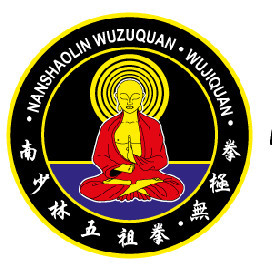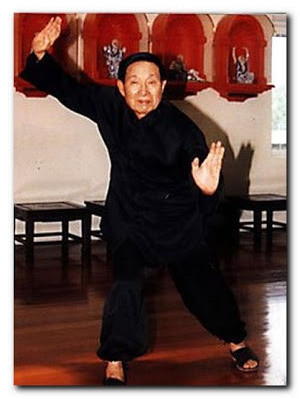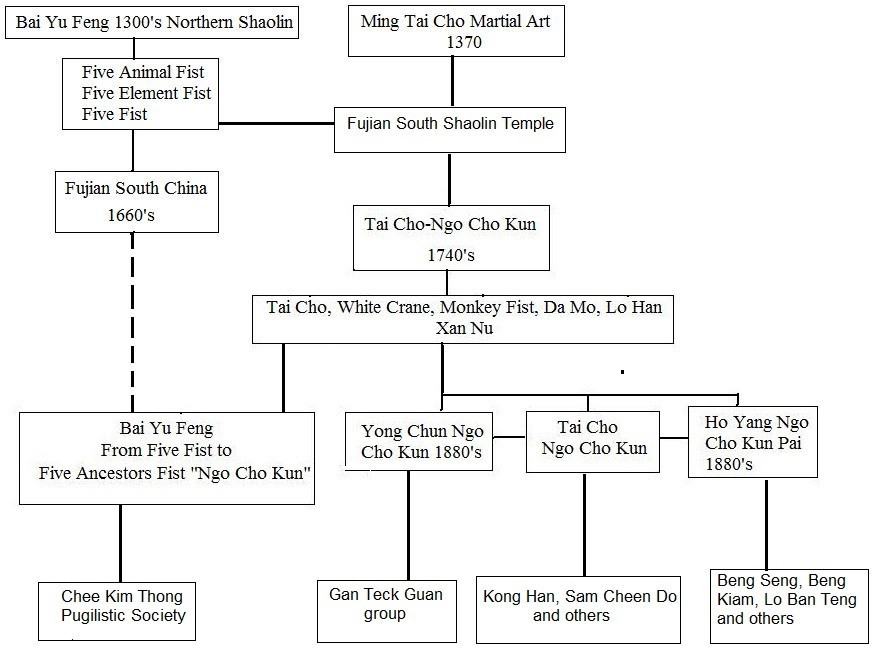We are going to look at the classical Chinese martial art of Nanshaolin Wuzuquan, this great martial art has a huge following globally. The roots of the martial art goes back to Bai Yu Feng 1300`s Northern Shaolin with Five animal fist, five element fist and five fist. You can find a school if you look in the right places.
Wuzuquan Lineage
Please see below the diagram of the lineage, Wuzuquan was promoted by Grandmaster Chee Kim Thong leaving many schools globally with many practitioners (see Chee Kim Thong Pugilistic Society on the lineage diagram below)
Typical Training Sequence
This art is very comprehensive and contains many aspects including breathing exercises, stretching, strength training, form works, techniques, bone conditioning weapon training etc
I trained in this art for many years, many years ago. This was an excellent foundation to my martial arts and a very enjoyable time with very skilled instructors and students’, I also got to see Grandmaster Chee Kim Thong when he was alive and attend a short seminar with him.
Please see below a typical training lesson at that time.
- Stance training: Developing the leg strength and core strength along with endurance, this training builds a strong foundation enabling you to be rooted to the ground and very hard to be uprooted. Great for balance, there are a number of stances which concentrate on different parts of the body some are even on one leg. Those positions are held for a number of minutes depending on the lesson (the longer the better, but you must maintain correct posture and balance etc.
- Joint warm ups: This will cover various exercises to warm up the joints: wrists, fingers, knees, shoulders, hips, back, neck elbows etc using rotational movements and bending movements etc You must ensure your joints are slowly and safely warmed up to prevent injury,
- Stretching: Leg stretching involving individual exercises and pairs exercises ensuring slow and steady progress preventing pulling any muscles which could put you out of action for weeks if not months. All other body muscles back, arms, neck sides shoulders etc
- Techniques (Single person) This was carried out in moving stances and static stances, involved various kicks front kick, turning kick, sidekick, back kick, reverse hook, etc all at different levels of height followed on with combinations of kicks. followed by kneeing. Then hand techniques were practiced in the same fashion various punched including straight punches, back fists, and special short range punching designed to develop short range power. My personal favourite punching technique rolling punch (this is unstoppable if done correctly)
- Techniques (Paired Persons) and Set Sparring: with one person defending and one person attacking with agreement to practice, we practice various combinations of punches, blocks / punches and kicks and blocks/ etc perfecting those movements and increasing in speed and strength depending on the level of your partner.
- Limb knocking: This was a two man drill designed to condition your forearms and legs and strengthen the bones. We used special Chinese medicine during this sessions put on our arms to prevent injury and condition the bone, The goal was the have arms like steel rods covering with cotton wool. To protect you if you are attacked and damage your opponent. This drill had to be done with care to prevent any injuries and you had to be mindful of beginners as they could get badly bruised of hurt,
- Two person Sensitivity drills: They were a number of drills designed to build up the students’ sensitivity those included static stance with one arm or two arms and moving stance with single arms special breathing technique was undertaken where required. Those were excellent for building up your stance and managing your tension in your arms and upper body.
- Sticky Hands: again designed for helping you develop sensitivity but this is a more competitive drill as you have to find your partners weaknesses in their structure and movement by causing them to be unbalanced and possibly move them.
- Empty Hand Form Training: this would involve working on the movements to the current form your were working on for your level of training but every one must do the first most important form which is Sanchien, (I will cover the forms later)
- Form Catching: A technique used to develop the application of the movements in the forms
- Weapon forms: there are also many weapon forms to learn those include, Staff, Short stick, Broad sword, Straight sword, Butterfly knife, spear. Quonto, Sys etc Those forms help develop body movement and stronger core, arms and legs.
- Free Sparring: This is controlled sparring semi – contact allowing students’ to practice various attacks and defense techniques free style keeping your reflexes sharp and develop skill.

Empty hand Forms
There are eighteen principal forms
- SANCHIEN: Emphasize on the four principles, Toon, Poo, Tim. And Tor (Absorb, Float, Sink and Release and Chi` development.
- ZEE CHAP KOON: Covers the essence of the punches, developing heavy punches.
- T`EO CHIAT: How to use the palming technique.
- CHOE CHIEN: Method of evading and dodging using the legs.
- PAK KAK: A combination of the first five forms applications.
- SIANG SWEE: Utilizing the twin fist method of defense and attack techniques.
- KOK CHER PEE` N Utilize the palm stroke-chopping, palm heel etc.
- ZEE CHART: Method of using waist, arm and elbow joints.
- T`HIN TOU: Dodging head movements to protect head.
- CHENG HONG: Concentrating on the speed and the main muscles of the body .
- HONG NAR CEW. Method of catching.
- TUAR SANCHIEN: Summary of the first eleven forms applications.
- HONG KAK: Method of using body joints .
- THAY SART Concentration on the ground techniques.
- PAK KUA: The eight diagram and refine foot and body movements .
- CHLO PAT SIAN: Drunken movements, Practicing all the unorthodox movements
- KIM LAI CHEAM: Hide needles in cotton wool.
- NGOR HENG KOON. Ch`i application

Deep Abdominal Breathing
The deep abdominal breathing is cleverly integrated into the key components in the forms so form training is essential and it`s very important if you decide to take up the great Chinese classical martial art you source a qualified instructor. This will ensure your form training is correct helping you develop your bodies Chi.
Conclusion
Nanshaolin Wuzuquan is an amazing classical Chinese martial art unlike the modern arts of today go back thousands of years and are very comprehensive. Covering many aspects.martial arts, this is a complete system developed and fine-tuned over thousands of years, Many masters have spent their lives working on the techniques and internal/ external exercises over the centuries.
Its Great this martial art still has a large global following and still growing. My own personal experience was amazing during my time training in this Chinese martial art giving the foundation for my ongoing martial arts training.
Hope you have enjoyed the post and maybe inspire you to seek out and take up the Complete system of Chinese martial arts.
Checkout my post on Grandmaster Chee Kim Thong
Please leave you comments in the box below it would be great to hear from you
Wince 🙂





Thanks for sharing the information about Wuzuquan with us! I know Shaolin but I do not know about this.I have to check out your post on Grandmaster Chee Kim Thong. Do you have any books or any video for this type of martial arts? How long have you practiced this? I have to look more into this. Thanks agian!
Hi Nuttanee, nice to see you again, and thanks for you comments, Wuzuquan is Shaolin but Southern Shaolin and has a long linage, please see the linage diagram in the post, Grandmaster Chee Kim Thong was spreading this art around the world before his passing and I did train Wuzuquan for many years and even attended a seminar with Grandmaster Chi for a day when he came over many years ago. There are not many books around but please visit this site for more details: NON SHAOLIN WUZUQUAN
All the best, see you soon.
Wince